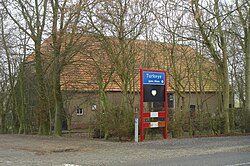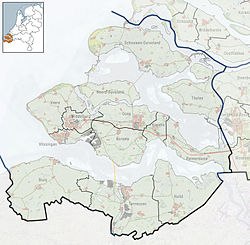Turkeye
Turkeye | |
|---|---|
 | |
Location of Turkeye in the province of Zeeland | |
| Coordinates: 51°19′05″N 3°34′55″E / 51.31806°N 3.58194°E | |
| Country | Netherlands |
| Province | Zeeland |
| Municipality | Sluis |
| Population (2020) | 20−30 |
Turkeye is a hamlet of Sluis, a municipality located in the west of Zeelandic Flanders, in the south-western part of the Netherlands.[1][2] Even though the settlement is regular village in the province of Zeeland, the name Turkeye is probably an old spelling for Modern Dutch Turkije (English: Turkey, Türkiye in Turkish). The name supposedly derives from relations between the Ottoman Turks and the Netherlands. The name of the road to this village is Turkijeweg which means Turkey Road in Dutch. The town has 20 to 30 inhabitants, all Dutch citizens.[3] The largest part of the houses in the hamlet serves as a holiday home. Although everyone in the village is Dutch, there is a sign on the doors of many houses saying Turkish: Ne Mutlu Türküm Diyene ("How happy is the one, who says 'I am a Turk'"). While many signs in the village contain the words Turkish: Hoş geldiniz ("Welcome"),[4] there are also paintings of Ottoman sultans on some walls. Monique Sturm, who has been a volunteer Turkish ambassador in the village for 30 years, turned a part of her house into a Turkish museum with items she brought from Turkey.[3]
The hamlet of Turkeye was part of the municipality of Waterlandkerkje from 1796 to 1970. In 1970, this municipality merged with the municipality of Oostburg, which in turn was merged into the municipality of Sluis. The history of Turkeye starts after the conquest of Sluis in 1604 by the State army. The defeated Spanish troops withdrew and left 1,500 galley slaves, among whom a large number of Muslims from the Ottoman Empire,[1] referred to in short as Turcken. The States-General decided to release these slaves and to send the Turks back to their homeland. So they hoped to acquire the support of the Ottoman Empire in the fight against Spain. However, the so-called Flemish Turks have once again been enslaved in Marseille, and have not been able to reach the Ottoman Empire.[5] Prince Maurits may have attached the name Turkeye as an extra tribute to the Schans Turkeye, which was constructed in the same year 1604 and to which the nearby hamlet would later be named.[2]
A bond has grown between the neighbourhood Turkeye and the Turkish community in the Netherlands and Turkey. A few inhabitants of the hamlet are involved, as well as the Stichting Vriendschapsband Nederland-Turkije. There are regular visits by Turkish delegations and dignitaries such as diplomats. There are also place name signs Turkeye, gem. Sluis placed in the Turkish cities of Dalaman and Trabzon, where many Dutch tourists come. In 2012, it was celebrated that there are 400 years of diplomatic relations between Turkey and the Netherlands: In 1612 the Republic of the Seven United Netherlands was recognized by the Ottoman Empire.[6]
References[edit]
- ^ a b "Avrupa'nın ortasında ilginç Türk köyü! Buraya ilk ayak basan Türk sizi çok şaşırtacak..." Hürriyet (in Turkish). 10 May 2018. Retrieved 30 March 2024.
- ^ a b "Zeeland - Ga deze zomer eens naar Turkeye: dat kan echt". Columbus Magazine (in Dutch). 12 April 2020. Retrieved 30 March 2024.
- ^ a b "Hollanda'da 19 kişilik Türk köyü". Post (in Turkish). 9 October 2022. Retrieved 30 March 2024.
- ^ "Hollanda'da masal gibi görüntüsü ile kendisine hayran bırakan Türk köyü". Türkiye (in Turkish). 9 October 2022. Retrieved 30 March 2024.
- ^ "Hollanda'da tarihi Türk köyü "Turkeye"" (in Turkish). Pause. 10 January 2022. Retrieved 31 March 2024.
- ^ Tekin, Ahmet. "Osmanlı-İngiliz Diplomatik ve Ticari İlişkileri Tarihine Bir Katkı: 1612 Ahidnâmesi". Tarih Dergisi (in Turkish). İstanbul Üniversitesi. doi:10.26650/iutd.20241274860. Retrieved 31 March 2024.

